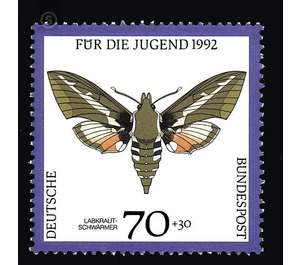youth: endangered moths - Germany / Federal Republic of Germany 1992 - 70 Pfennig
Theme: Animals
| Country | Germany / Federal Republic of Germany |
| Issue Date | 1992 |
| Face Value | 70.00 |
| Color | multi-colored white blue |
| Perforation | K 13 3/4 |
| Printing Type | Multicolor offset printing |
| Stamp Type | Postage stamp |
| Item Type | Stamp |
| Chronological Issue Number | 1476 |
| Chronological Chapter | GER-BRD |
| SID | 743244 |
| In 30 Wishlists | |
Whoever speaks of butterflies usually means the colorful, flower-visiting butterflies that fly in the sunshine during the day, such as the peacock's eye, the little fox or the cabbage white. Few know that about nine-tenths of all butterflies belong to the so-called "moths." However, this is a rather inaccurate (and unscientific) collective term that encompasses everything that is not just "butterflies", a vast, heterogeneous set of at least 150,000 species worldwide, to which about 60 different "families" are assigned (for comparison: butterflies, for example) 13,000 species, 5 families). The only thing they have in common is their nocturnal way of life (and even that is far from being the case in every species, as many have become diurnal again). The fact that they fly around at night, being lured by light sources and sometimes getting into apartments, is probably the main reason why this large group of insects has either remained largely unknown to the layman or even occasional encounters with these "moths" are considered unpleasant, though they are completely harmless. Hardly anyone knows, therefore, the splendor and beauty of many species, at least comparable to the butterflies, or the subtle aesthetics of the other, less conspicuously colored species. There are more than 2,000 species of moths in Germany and of course they are - as well as the butterflies - endangered by human interference in the natural environment and threatened in part their existence. That they, too, are an indispensable and worthy part of a whole, to which, last but not least, man belongs, is to draw attention to the small selection of native moths. The butterfly family of the "swarmers" (Sphingidae) is relatively poor in species; There are only about 850 species known worldwide. All species are powerful, enduring fliers and can - like a hummingbird - fly on the spot. They use this ability to suck nectar from deep calyxes with their often over-body trunk. Some species can be seen at dusk, others fly during the day, but most are nocturnal. The caterpillars of the Schwärmerarten feed on both the most diverse woody plants and herbaceous plants and often become very large. They wear a distinctive horn at the top of the abdomen and are thus well recognized as belonging to this family. The Labkrautschwärmer (Hyles gallli) is a medium-sized species with about 5-7 cm span. It inhabits mainly warm dry areas with sandy soil (heaths, clearings, forest edges). The large, usually dark to black-green caterpillar with the conspicuous yellow patches preferred in some areas as a food plant the Labrador (Galium verum), but also on forest clearings common narrow-leaved willowherb (Epilobium angustifolium) is readily accepted. The pupation takes place in the earth. The doll hibernates, the moth flies in May. In warm years, a partial second generation may occur. Hazard factors: Afforestation of extensively used dry areas, maize cultivation on sandy marginal land.


